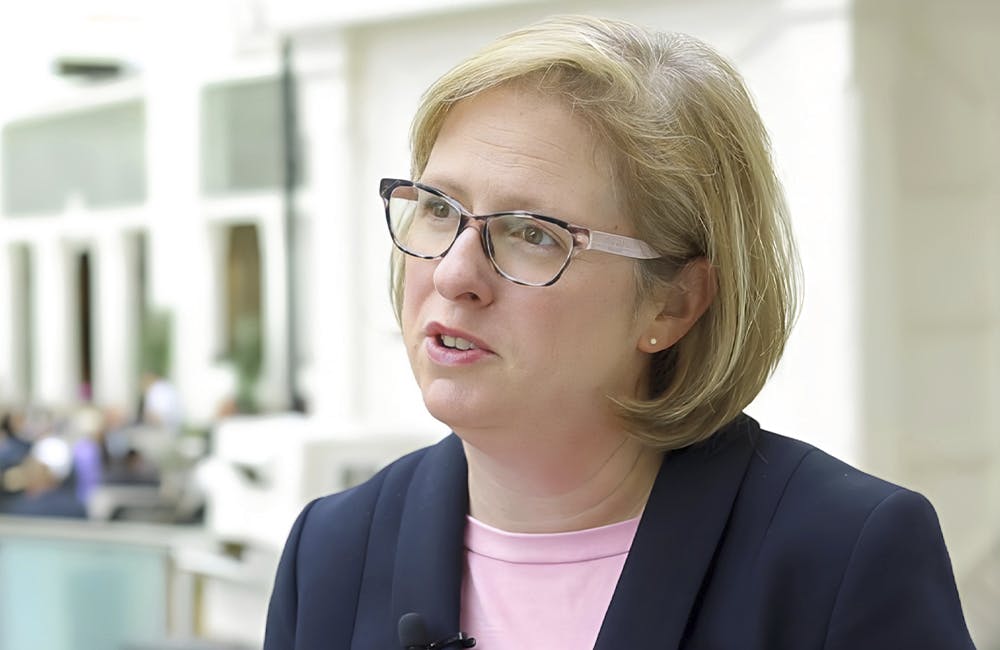Report: Recruitment and Retention Strategies for Women in Government
Federal leaders highlight challenges to getting more women into government and how to foster a strong work culture where women can flourish.

During GovCIO Media & Research’s inaugural Women Tech Leaders Working Group meeting in December 2022, women tech leaders from across government and industry gathered to discuss challenges around recruiting women for government careers, retaining women in those roles and creating a diverse, equitable work culture that supports women from different backgrounds across stages of life.
Notable highlights from the inaugural meeting include improving pay and compensation, honing marketing and recruiting efforts to persuade women to pursue government jobs, and reducing barriers to entry including non-user-friendly hiring practices.
The Makeup of Women in STEM Roles
According to a 2022 report from the U.S. Equal Employment Opportunity Commission, women account for 29.3% of STEM federal workers. Women occupy science-related jobs the most (49,546), while math, technology and engineering occupations in the federal government have a significantly low number of women, and the gender disparity is greater in leadership roles.
The number of women in STEM is lower than their male counterparts due to various reasons, including lack of representation, role models and mentoring, implicit bias both in the hiring process and while on the job, lack of flexible work options due to additional roles that women tend to take on such as caregiving for elderly or disabled family members, or child care.
“29% of the federal STEM workforce are women, and only 25% of those are in leadership positions. This seems to be due in part to the fact that there is essentially a mother tax for women who have children, but also that women in the private sector are making less money in STEM jobs, and this is being perpetuated in the federal government. So there’s a real question about the use of salary history when addressing commitments to diversity and inclusion,” Liza Zamd, attorney advisor in the Office of the Vice Chair at the Equal Employment Opportunity Commission, said during the GovCIO Media & Research Women Tech Leaders event in July 2022.
Show Me the Money
While there have been significant improvements addressing salary equity in the federal government, the gender wage gap and a lack of parity with the private sector still hinder women from embracing careers in government.
The EEOC report examined the average base salary and found the difference in pay between male and female STEM workers in the federal government is around $4,305.90 per year. The federal government also competes for talent with private tech companies more likely to offer generous sign-on bonuses, conduct pay equity audits more often, and set clear policies for pay and promotion.
Women Tech Leaders working group members discussed how agencies could better advertise existing benefits as many job seekers flee to the private sector or never apply for federal jobs in the first place due to the lack of knowledge about the types of benefits the federal government offers.
“When you come to work for the government, you get different benefits, like tuition reimbursement,” Cynthia Kaiser, FBI Cyber deputy assistant director, said during the working group meeting Dec. 7. “Our HRs aren’t doing that. I found out through a candidate who rejected our offer. She started walking me through, ‘well, don’t you know, we have this and this,’ and she’s like no, I didn’t know any of that.”
Working group members also agreed more conversations need to happen around the benefits of working in the government tech field as a woman.
“Being able to talk about how the government is a great place for women, for diverse communities. It’s not perfect, but it can be less toxic than some of the technology companies out there where there’s a lot of pay disparities,” Kaiser said. “We don’t play up enough that it is sometimes easier to be female in government tech than it is in some of these tech industries. I think we could do a better job of rooting through that message. And you can grow quicker.”
Marketing the Government Mission
Government doesn’t always market itself well for the up-and-coming tech workforce. Working group members said agencies could be doing more to tout their missions and advertise unique benefits.
Karen Howard, executive director for the Office of Online Services at the IRS, would also like to see agencies expand their public image.
“We need more people to join the agency to join us in our mission to make tax compliance simpler,” Howard said during the Dec. 7 meeting. “Many potential recruits get caught up in an agency brand that focuses on compliance and enforcement, but that’s not the holistic view of what the IRS is. There are several business units focused on service and experience; additionally, the IRS is huge in the benefits administration enablement side, but people don’t see that part. I was driving the other day, and a commercial comes on saying, ‘Is the IRS after you?’ To transform the recruitment efforts to be more targeted and intentional, it’s really about flipping the narrative so that it appeals to the people you’re trying to recruit.”
Major tech companies, especially those based in California, advertise themselves as dynamic and exciting places to work. But sometimes the innovative work happening in federal government doesn’t leave the Washington echo chamber.
“We’re not always great at telling our story,” said Nicole Gilbride, chief strategy officer at the Department of Veterans Affairs’ Office of Information and Technology, during the Dec. 7 meeting. “At the VA, we do have a legacy of being very innovative and very cutting edge. Nobody else on the entire planet has one million individuals’ medical genome data captured and is using it for scientific research. But when you think, ‘Where can I go to get the world’s best genome data?’ You don’t always think the VA.”
Howard would also like to see government specialize its messaging to help attract talent from different generations.
“Understanding the data, understanding the audience, and coming with a bespoke narrative that really appeals to prospective recruits and floats their boat,” Howard said. “Younger generations want flexibility in their work day. Talk about that. Talk about the things that matter to your targeted talent needs. And when I’m talking to someone more seasoned in their career, we talk about stability, making a difference, and about a more flexible working environment. It’s about knowing your audience and crafting a recruitment narrative that appeals.”
When it comes to recruiting tech workers, Gilbride also spoke about the importance of applicants’ first digital experience and making improvements to the design of USAJobs. “If we want to bring great people in, we need to have that intake experience look and feel the way we want the skill sets we’re developing to look and feel,” Gilbride said.
Breaking Down Walls
There is little dispute that women are underrepresented in STEM professions, and it all starts with access. Lengthy hiring processes, lack of data, a non-user-friendly USAJobs site and a challenging security clearance process are all barriers that prevent women from entering the technology workforce in the federal government.
Brooke Jordan, lead for stakeholder engagement at VA, said it is crucial for the federal government to position itself as an exciting place to work with an important mission, just like private tech companies do.
In order to make women feel more comfortable when applying for tech jobs in the government, there needs to be more messaging around how to market transferable skills better, even if women do not have all the education requirements for a specific job.
Akanksha Sharma, director of digital transformation at the Department of Labor, said it all starts with a diverse HR department. “We need more diversity in your hiring managers. They are the ones who will try the more creative stuff,” she said.
While all the working members agreed the USAJobs user interface, lack of real-time updates and incomplete job listings contribute to a lot of applications slipping through the cracks, not having the inside track also contributes to hiring fewer women for STEM positions in the federal government.
“One of the barriers that we’re trying to work through is navigating the process of getting in, like knowing how to interview and feeling confident enough to interview,” Kaiser said. “There are entire groups of people who don’t have that inside track or that feeling like they have the inside track, and then there becomes a lack of confidence in applying.”
Self-perpetuating hiring systems also contribute significantly to the gender disparity in the tech field.
“Our system is set up to hire people that are already like us, our whole way, especially as you go up the ladder. Yes, it is not designed to hire people from the outside in. It’s not designed to hire people that don’t look like the people that are already there. They don’t know the game. And so as you go up the ladder, there are more men and less women and less diversity. And it’s like a system that keeps feeding itself, the way those questions are phrased. The way the job descriptions are written. I can’t hire brilliant people right out of college for my lower-graded roles because they’re written as if you’ve got to have 17 years experience in the government in order to even be competitive for this job,” Gilbride said.
Diversity Matters
Recruiting a diverse workforce is only half of the battle. Government also has work to do when it comes to developing, promoting and retaining women in the workforce.
“It’s at about that three-to-seven-year mark where you realize that the further up the ranks you go, the less women and the less diversity you’re going to see,” Gilbride said. “In my last role, I was the only woman out of eight senior leaders at the table.”
Federal women tech leaders have also noticed a shift in the kind of feedback they receive as they move up the ranks.
“People start giving you feedback that’s personality-based when you’re coming up,” Kaiser said. “When you start getting the leadership quality feedback, it becomes, ‘Well, sometimes in meetings you’re like seen as really aggressive.’”
Biasinterrupter.org is a resource for how to give performance-based feedback and coaching. Kaiser also promoted “unconscious bias intervention,” as a way of promoting a positive culture shift.
“When we see things, you can say, ‘Hey, that’s not really being fair to that person.’ Or, ‘That sounds like personality-based feedback and not a competency issue.’ Or, ‘That’s hard feedback for me to take because it feels like you’re over-indexing on one weakness I have compared to my overall strengths. I don’t know if my other colleagues get that.’ We should be able to be very direct because most people want to better understand how they can support diversity in the tech fields.”
Gilbride also spoke to the importance of mentoring — or, if you don’t have time to mentor, sponsoring the next generation of women tech leaders.
“I don’t have cycles to spend doing the culture work and opening up the aperture of my fellow leader’s perspective,” Gilbride said. “I find myself sponsoring more frequently than mentoring. I try to keep my eyes and ears open as to who are the rising stars. Who are those smart, intelligent people, so that when a new project is coming up, I can say, ‘Let’s grab Sophie and bring her in,’ or ‘Let’s grab Dominique and bring her in on it.’ If you don’t have time to do mentorship, at least find time to do sponsorship and advocacy.”
From Gilbride’s perspective, it’s important that tech leaders use their position to uplift others and become comfortable having uncomfortable conversations.
“Changing the culture requires calling out bias when you see it and then helping women navigate bias,” she said.
Supporting Women Through Stages of Life
One of the issues regarding the retention of women in STEM occupations in the federal government has to do with the lack of enough resources provided to women as they move through various stages of their lives, such as maternity leave or caring for family members.
“Our team talked quite a bit about maternity leave and how that impacts women’s careers and how to improve that,” said Andrea Fletcher, executive director of digital service at CMS. “CMS has done a really great job actually of hiring and keeping women in leadership. The in-person days CMS had low-cost childcare on-site. So, women would bring their children to the Baltimore office. There are a lot of families that work at CMS and have children at the childcare center, which is fantastic! In a remote world, I don’t know how that’s going to work for us. I think we’re going to really struggle to maintain the amazing, talented women who go on maternity leave without improving both maternity leave and childcare benefits.”
To encourage more women to join and subsequently stay in tech professions, offering more tailored benefits and promoting flexibility in where, when and how employees work could enable a culture showing more support for family responsibilities.
“My boss has children and a ‘when my kid is sick, I am not working’ policy. Demonstrating that makes me feel comfortable and I know that I have the same flexibility. That trickle-down effect is important. Demonstrate that,” Gilbride said.
“I think the point of having benefits tailored to where you are in life is really important,” Sharma said during the Dec. 7 meeting. “Not having blanket generalized benefits, but having them be a little bit more personalized. Some tech companies have started offering [fertility treatment] or paying for some portion of that, things along those lines — tailored benefits would go a long way toward attracting and retaining talent.”
Another challenge women face in this field is not being able to take time off work to care for children or family members and return to the same level of work, along with the “hazing culture” affecting all employees in a workplace.
“I think there’s a bigger undercurrent, though, of what I call the hazing culture,” Gilbride said. “Where because I had it rough, I want you to go through the same roughness I went through… We don’t want to give that flexibility because we had to suffer through it, so they need to suffer through it too. I feel like hazing is more male-dominated, but we kind of buy into that by nature and like breaking that is the system paying your dues.”
This is a carousel with manually rotating slides. Use Next and Previous buttons to navigate or jump to a slide with the slide dots
-

How Agencies are Upskilling the Workforce in AI
Federal officials are putting in place new training and education methods to ensure its overall workforce understands the technology.
3m read -

A Prepared Workforce is Key to Cyber Resiliency
Strong training strategies and emphasizing cyber hygiene basics enhance security practices at federal agencies.
2m read -

Navy Invests in Additive Manufacturing Workforce to Match Pentagon Strategy
DOD issued its Additive Manufacturing Strategy in 2021 to integrate with the private sector and create agile uses of the technology.
5m read -

Defense Officials: Cyber is a Sport That Needs Strong Teammates
Coast Guard, Marine Corps and Navy officials said they are working on new hiring strategies and partnerships amid evolving threats.
5m read








